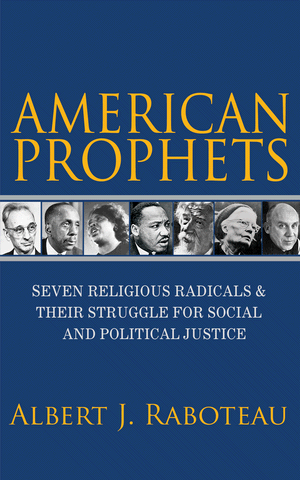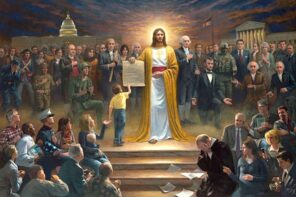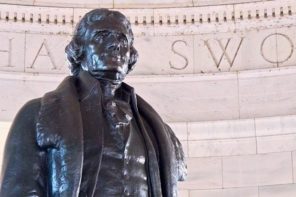Princeton’s Albert Raboteau, whom Cornel West aptly calls the “legendary godfather of Afro-American religious studies,” offers in this compact volume a rich group portrait of seven 20th-century freedom fighters rooted in the prophetic tradition. Most of the pieces are distilled from a popular course that Raboteau taught for years, but may it be said that such distillations are often valuable to have, especially coming from scholars who have done their work this well and deeply.
Raboteau’s prose is spare and elegant, and the book will be instructive even for people who think they know all they need to about the members of this Magnificent Seven. And it’s bracing to read about fearless American originals as we await the demolitions and predations of the coming Trump years.

American Prophets: Seven Religious Radicals and Their Struggle for Social and Political Justice
Albert J. Raboteau
Princeton University Press
September 2016
The seven are well chosen: Abraham Joshua Heschel, A.J. Muste, Dorothy Day, Howard Thurman, Thomas Merton, Martin Luther King, Jr., and Fannie Lou Hamer. I’m sorry to say that the chapter on Dr. King is something of a throwaway; it may be the case that Raboteau feels that King’s exceptionally strong theological and spiritual rooting in the Bible’s revolutionary counterscript has been sufficiently explored by others.
Robateau was shrewd to place his portrait of Heschel up front, as his remarkable and important biblical scholarship evoked the prophetic consciousness in a clear and powerful way. The prophet, wrote Heschel, is connected to the divine pathos, the divine suffering in the face of injustice and wrongdoing. The prophet’s G-d consciousness is often painful, as in the classic case of Jeremiah complaining of the fire shut up in his bones. And the prophet is always impelled to communicate this pathos to a sometimes-oblivious public.
What the Authorized Version renders in English (beautifully, in my view) as “lovingkindness,” forms the essence of godliness. A heart filled with justice-love, joined naturally to a defiance of despair, is the only thing that qualifies us to be G-d’s partners in the redemptive struggle.
To be clear, Heschel went all the way with this, and was often attacked in his long lifetime by other scholars who were unable to see and feel the same texts as radically subversive. Heschel maintained that prayer itself is meaningless, and impious, unless it is subversive. Thus he came to the 20th-century black freedom struggle from a very pure place of full immersion in the texts. Dr. King, whose own innermost consciousness was utterly suffused in Sacred Scripture, was bound to be a natural soul brother for a rara avis like Heschel.
The Heschel portrait is followed by a fascinating quartet of chapters reviewing the thought and work of Muste, Day, Thurman and Merton who were connected, directly or indirectly, by means of networks like the Fellowship of Reconciliation and mentors like the little-known Quaker thinker, Rufus Jones.
Free spirits, indeed! Muste migrated from the strict Dutch Calvinism of his youth to become the leader of the Lawrence Textile Strike in 1919 (not the original “Bread and Roses” strike but a sequel). Without ever recanting his working class commitments or his Trotskyite leanings, Muste rejoined the Fellowship of Reconciliation in 1936 and shaped FOR’s compelling pacifist message down to the present day.
Recalling that pacifism and revolutionary nonviolence formed the very core of Jesus’s witness, Muste went head to head in open debate with “realist” Reinhold Niebuhr, very much holding his own against the best-known theologian of the century. Muste’s consistent witness had a significant influence on civil rights leaders Bayard Rustin, James Lawson, Jr., and James Farmer. Dorothy Day knew and admired Muste, and Muste must have felt enough of a kinship with Thomas Merton to pay Merton a visit in Kentucky.
Dorothy Day’s bio is every bit as colorful, but unlike Muste, she migrated from a secular youth to a defiant decision to be baptized in 1927 at the age of thirty. Like Muste, Day never apologized or regretted her wild bohemian youth. She simply refocused her passion for the things of this world by insisting that the essential things—food, clothing, shelter, companionship—be made available to the “least” of God’s children. Day fully believed that in serving the poor and despised, she was serving the living Christ. Day’s three “p’s”—poverty, personalism, and pacifism—still resonate today, well beyond the remaining Catholic Worker communities. It’s certainly noteworthy that Pope Francis praised Day and Merton (along with Lincoln and King) in his address to Congress last year.
As for Thomas Merton, Raboteau finds affinities not only with activists Muste, Day, and King, but also with Heschel—inasmuch as Merton was a serious intellectual whose radicalism grew out of his immersion in sacred texts and out of his contemplative life. Merton may have “retired” to the Gethsemani Abbey, but he remained remarkably attentive to the pathos and suffering of black America. As his justice commitment grew, Merton was unflinching in critiquing his earliest and best-known work, The Seven Storey Mountain, for being so focused on the importance of contemplation as to be acquiescent in relation to social injustice.
But Raboteau is at his very best in evoking Howard Thurman’s under-appreciated greatness: his distinctive and powerful nature-based mysticism, his prescience in respect to the spiritual cost of environmental degradation, his “ecological” analysis of the unspeakable damage segregation inflicted on the psyches of African Americans. Of all the prophets treated by Raboteau, Thurman is clearly the one who has the most to say to our present situation.
Raboteau again shows us the connective threads linking Thurman to other prophets: his decision (as a sophomore at Morehouse College!) to join the Fellowship of Reconciliation, his later tutelage by the same Rufus Jones who had influenced Muste, his early encounter with Mahatma Gandhi, and his commitment (parallel to Dorothy Day’s) to create and live within a real existing community of saints. In Thurman’s case, that real existing community was the interracial Church for the Fellowship of All Peoples in San Francisco, which he left a comfortable position at Howard University to co-found in 1944.
Civil rights hero Fannie Lou Hamer, who had no formal education other than Bible study beyond the sixth grade, might at first glance seem to be something of a bad fit with the other figures in Raboteau’s book. But Raboteau makes a convincing case that Hamer, who mightily irritated Lyndon Johnson at the Democratic Convention in 1964 (and here is her justly famous testimony), does indeed belong on his personal Mt. Rushmore.
In quoting extensively from her speeches Raboteau reminds us that Hamer’s distinctive fusing of biblical and (lower-case “r”) republican rhetorics packed the same quantum of unmistakable prophetic power as the more grammatically-correct utterances of King and Heschel. Despite being horrifically tortured (and permanently injured) by white terrorists in her native Mississippi, Hamer consistently told white people, including her torturers, that she as a Christian sought reconciliation, not revenge. And then there is that incredible singing voice of Hamer’s: you listen to that voice, and you understand what it is to prophesy.
My pastoral advice for today: read Raboteau with your own deepest contemplative consciousness. Then ask yourself, How must I now live?





